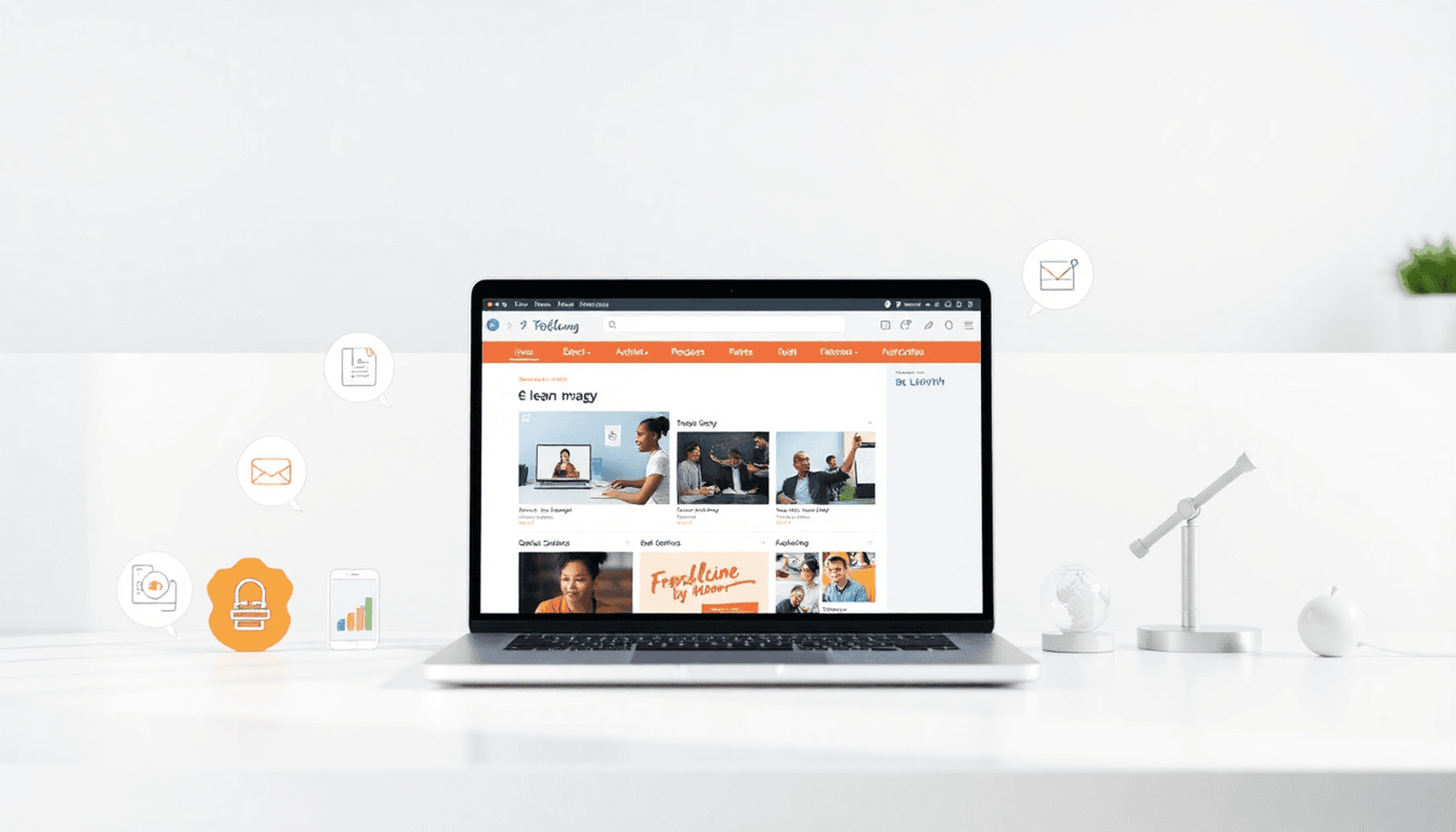Subscription models in the PLR e-learning space refer to recurring access plans where educators, entrepreneurs, and content creators pay regularly to obtain a library of Private Label Rights (PLR) courses and materials. These models grant ongoing usage rights to pre-made, customizable educational content designed for branding, reselling, or personalizing.
PLR licenses provide professional-grade courses that can be tailored to specific audiences without starting from scratch. The e-learning space thrives on these ready-made resources, enabling faster course creation and scalable business opportunities. For instance, platforms like Uthena offer a wide range of PLR video courses that can be bought and sold by users while retaining all earnings for life.
Subscription models are crucial for educators and entrepreneurs who want a steady stream of fresh, adaptable content while avoiding the delays and costs of developing new courses independently. This approach supports consistent growth, flexibility in offerings, and financial predictability in a competitive marketplace.
Moreover, with the right subscription model, users can gain access to specialized courses such as finance-related PLR courses, which cover various aspects from personal finance to cryptocurrency. Similarly, educators looking to expand their course offerings can explore diverse subjects through platforms like Uthena which also hosts collections from various instructors like Joseph Delgadillo and Maiza Nara.
Pros of Subscription Models in the PLR E-learning Space
1. Recurring Revenue Stream
Subscription models in the PLR e-learning space offer a powerful advantage: a recurring revenue stream. Unlike one-off sales, subscriptions generate predictable income by charging members on a regular basis—monthly, quarterly, or annually. This steady cash flow enables businesses to plan budgets and investments with more confidence.
Key benefits of recurring revenue include:
- Consistent income: You avoid the feast-or-famine cycle common in traditional product launches. Instead of scrambling for new sales constantly, you build a reliable financial foundation.
- Financial stability: Predictable subscription payments help cover fixed costs such as platform fees, content creation, and marketing efforts without constant pressure to acquire new customers.
- Easier scaling: With recurring revenue, you can forecast growth more accurately and allocate resources toward expanding your course library or upgrading technology.
- Improved cash flow management: Knowing when payments will arrive allows smoother handling of operational expenses and potential reinvestment into business development.
For educators and entrepreneurs working with PLR licenses, this model creates an opportunity to monetize content continuously rather than relying solely on individual course sales. Offering access to a broad catalog of customizable courses under subscription means you attract users who prefer ongoing learning experiences over single purchases.
Platforms like Uthena illustrate this well by providing whitelabel PLR video courses that subscribers can access anytime. This encourages long-term engagement and loyalty because members feel they receive ongoing value—not just a one-off product.
A subscription model also reduces the risk associated with new content launches. Instead of betting everything on one course release, it spreads income sources across multiple offerings within the membership. This diversification supports business resilience during market fluctuations or shifts in learner demand.
You gain the ability to focus on improving user experience and adding fresh materials knowing your revenue base remains stable month-to-month. This financial confidence is critical for sustainable growth in the competitive e-learning landscape where PLR content plays an increasingly vital role.
Moreover, platforms like Uthena not only provide video courses with private label rights but also offer various other course categories such as hobby courses and innovative tech solutions through profiles like Arbaz Khan.
2. Access to a Variety of Content
Subscription models in the PLR e-learning space offer significant advantages through customizable content. You gain access to a wide range of courses, materials, and resources that can be easily tailored to fit your brand or specific audience needs. This flexibility allows you to rebrand and modify content without starting from scratch.
Key benefits include:
- Time savings: Ready-made courses eliminate the need for lengthy content creation, letting you focus on marketing and engagement.
- Resource optimization: Instead of investing heavily in content development, subscriptions give you continuous access to fresh materials.
- Diverse topics: You can cater to multiple niches by choosing from various course options included in the subscription.
For instance, you can explore Dr. Elisaveta Pavlova's expert insights and resources or take advantage of Jerry Banfield's transformative courses on addiction, relationships, and entrepreneurship. If you're interested in enhancing your skills with AI, there are also numerous top AI courses available that can help advance your career. Furthermore, the subscription model also offers access to a variety of design courses, broadening your learning spectrum.
This approach supports businesses seeking efficiency while maintaining quality. It leverages the pros of subscription models in the PLR e-learning space with predictable income streams and adaptable content that grows with your business needs.
3. Scalability and Efficiency
Subscription models in the PLR e-learning space unlock significant scalability for your business. With a predictable income stream generated by recurring revenue, you can confidently plan growth strategies without the uncertainty of one-off sales. This steady cash flow supports reinvestment in marketing, platform enhancements, or expanding your course library.
Resource optimization is another key advantage. Instead of investing heavy upfront costs in content creation, you leverage professionally developed PLR courses that are ready to customize and deploy. This reduces time spent on content development and frees up your team to focus on customer engagement and platform management.
The combination of cost efficiency and scalable offerings creates an environment where you can serve more learners without proportionally increasing expenses. Your ability to handle rising demand smoothly is enhanced by subscription models, making it easier to expand your reach and impact within the e-learning market.
In this context, exploring high-quality resources available through platforms like Uthena can further elevate your business success. For instance, Alex Genadinik's expert courses on entrepreneurship, SEO, and marketing are designed to provide valuable insights and skills that can significantly contribute to your growth strategy.
4. Diversified Offerings
Subscription models in the PLR e-learning space allow you to combine membership site models with other product offerings, creating multiple revenue streams. You can offer tiered subscriptions, bundling high-value courses with lower-priced entry points that appeal to different segments of your audience. This approach expands your market reach by attracting both budget-conscious learners and premium buyers.
By providing a variety of access options — from basic monthly subscriptions to all-access annual plans — you cater to diverse preferences and budgets. This flexibility increases customer acquisition and retention. Affordable entry points act as a gateway, encouraging new users to explore your content before committing to higher-tier plans.
Mixing subscription income with one-time purchases or exclusive coaching upsells boosts recurring revenue while maintaining room for additional growth opportunities. The ability to diversify offerings positions your business for sustainable success through predictable income streams and broader market appeal.
5. Regular Content Updates
Importance of updating content libraries
Regular content updates are essential in the PLR e-learning space to maintain relevance and quality. By consistently refreshing your offerings, you keep your subscribers engaged and interested in staying on board. This practice also ensures that your content remains current and aligns with the latest industry trends and developments.
Encouraging member engagement and referrals
When subscribers anticipate new content regularly, they are more likely to remain active members of your platform. Additionally, updated content can spark discussions and interactions among members, fostering a sense of community within your e-learning environment. Satisfied members who benefit from fresh material are also more inclined to refer others to join, helping to expand your subscriber base organically.
By prioritizing regular content updates, you not only enhance the learning experience for your existing members but also attract new ones through word-of-mouth referrals and positive user experiences.
6. Flexibility for Members
Subscription models in the PLR e-learning space offer significant flexibility that enhances the learning experience. You empower members by providing self-paced learning options, allowing them to absorb content according to their schedules and preferences. This autonomy creates a user-friendly environment where learners feel in control, which can boost motivation and completion rates.
Members appreciate the ability to revisit courses or skip ahead without pressure, tailoring their education to fit individual needs. For instance, a member interested in mastering Linux and CyberSecurity could benefit immensely from Ramsai Dupati's specialized courses, while another member looking to delve into web development or digital marketing could find Laurence Svekis's courses invaluable.
Flexibility also supports diverse learning styles—whether visual, auditory, or kinesthetic—by offering varied formats within PLR content libraries. A good example of this is Lambros Lazopoulos's content, which showcases his unique approach to content creation through filmmaking and photography.
From a business perspective, this flexibility contributes to consistent engagement and reduces cancellation risk. When learners control their pace, they perceive higher value, making subscription models an attractive choice. The recurring revenue benefits become more predictable as satisfied members continue their subscriptions for ongoing access to customizable, on-demand content tailored for convenience and effectiveness.
Cons of Subscription Models in the PLR E-learning Space
1. Quality Variability
Subscription models in the PLR e-learning space come with a notable challenge: quality variability. Not all PLR content is created equal, and the range of quality can vary widely depending on the provider. Some courses, like those offered by Uthena, are professionally produced with high-quality video lessons, while others may feel rushed or outdated. This inconsistency impacts your brand’s reputation if you rely heavily on PLR materials without careful selection.
Key issues include:
- Generic content: Many PLR courses are designed for mass distribution, resulting in material that lacks uniqueness or depth.
- Outdated information: E-learning topics evolve quickly; static PLR content can become obsolete, making your offerings less valuable.
- Variable production standards: Differences in audio quality, video resolution, and instructional design affect learner engagement and satisfaction.
Addressing these quality issues requires active customization of the PLR content you subscribe to. Customization does more than just improve value—it helps you avoid duplicate content penalties from search engines. Duplicate content penalties can severely limit your site’s visibility and reduce organic traffic, which is critical for subscription-based businesses relying on continuous member acquisition.
Customization strategies include:
- Rebranding courses with your unique logo and style
- Updating course materials to reflect current trends and insights
- Adding exclusive bonuses or supplementary resources
- Incorporating personalized assessments or interactive elements
These efforts transform generic PLR into a tailored learning experience that resonates better with your audience.
Customization challenges arise from:
- Time investment required to edit and enhance content
- Technical skills needed for video editing, graphic design, or LMS integration
- Balancing between preserving core course value and adding new elements
Despite these hurdles, customization is essential for maintaining credibility and differentiation within a crowded market. It also ensures compliance with licensing terms since many PLR providers require modification before resale or redistribution.
Understanding the cons of subscription models in the PLR e-learning space, especially concerning quality variability and customization challenges, empowers you to make informed decisions. You can leverage subscription benefits effectively by anticipating these pitfalls and planning accordingly. For instance, opting for PLR bundles from Uthena can provide multiple high-quality courses at incredible prices, while their Master Resell Rights video courses offer an opportunity to buy Private Label Rights to hundreds of new and hot topic online courses bundled together and easy to download!
2. Technical Challenges
Subscription models in the PLR e-learning space come with specific technical challenges that can impact user experience and business efficiency. Setting up and managing membership platforms requires a solid understanding of subscription management tools, payment gateways, and content delivery systems. Without proper integration, members may face access issues or delayed content updates, which can lead to frustration and churn.
Handling customization challenges is another critical aspect. PLR content often needs modification to avoid duplicate content penalties from search engines and to maintain uniqueness that appeals to your audience. This requires both technical skills and time investment, which can strain resources if not planned carefully.
Common hurdles include:
- Ensuring smooth signup, billing, and renewal processes
- Managing different membership tiers and access levels
- Integrating automated email sequences for engagement and retention
- Troubleshooting platform glitches promptly to minimize downtime
Addressing these technical points effectively keeps the subscription model sustainable and user-friendly while avoiding pitfalls that often come with complex digital product delivery systems.
3. Ongoing Maintenance Requirements
Subscription models in the PLR e-learning space demand consistent platform maintenance to ensure seamless user experience and content delivery. Ignoring regular updates can lead to technical glitches, outdated content, and a decline in subscriber satisfaction.
You need to address customization challenges regularly to avoid duplicate content penalties, which can harm your platform's search engine rankings. Customizing PLR materials not only helps with SEO but also keeps the content fresh and relevant for your audience.
Effective engagement strategies play a critical role in retaining subscribers. Consider incorporating interactive elements like quizzes, discussion forums, or live Q&A sessions alongside PLR courses to boost participation. Sending regular updates about new content releases or special offers can maintain subscriber interest.
Key points to focus on:
- Routine platform updates for smooth functionality
- Regular customization of PLR content to maintain uniqueness
- Active engagement through varied learning formats
- Communication with members to build loyalty
These ongoing efforts reduce churn risks and enhance the long-term value of subscription services within the e-learning market.
To further enrich your platform's offerings, you might want to explore high-quality PLR materials from experienced professionals like Rahul Agarwal. His resources could provide valuable insights and content that align with your customization needs.
4. Risk of Member Churn
Member churn is a significant concern within the Cons of Subscription Models in the PLR E-learning Space. Subscribers often cancel when content feels repetitive or outdated, which can result from customization challenges and the presence of duplicate content penalties. It's essential to focus on delivering relevant and engaging material that resonates with your audience's evolving needs.
Key strategies to combat churn include:
- Regularly updating offerings to maintain the perception of fresh content.
- Ensuring courses reflect current trends and learner preferences.
- Customizing PLR courses to add unique value and avoid penalties related to duplicate content.
- Monitoring subscriber feedback closely to align content with audience interests.
Keeping your educational materials dynamic and tailored helps sustain subscriber interest. This approach not only reduces cancellations but also builds trust, reinforcing the value of your subscription service in a competitive e-learning market.
The balance between providing consistent updates and maintaining quality directly influences member retention, highlighting a critical factor when weighing The Pros and Cons of Subscription Models in the PLR E-learning Space.
5. Market Competition
Subscription models in the PLR e-learning space face the challenge of intense market competition. Many providers offer similar courses, making it difficult to differentiate your offerings without strategic niche selection and strong branding. You need to identify specific market segments where your content can solve unique problems or provide a fresh perspective.
Customization challenges play a critical role here. Simply repackaging generic PLR content risks duplicate content penalties and diminishes your value proposition. To stand out, invest time in tailoring courses with unique insights, updated information, or supplementary materials that resonate with your target audience.
Adding value goes beyond course content alone. Consider interactive elements like quizzes, live Q&A sessions, or exclusive community access to enhance subscriber experience. These differentiation strategies increase perceived value, improving retention and reducing the cons of subscription models in the PLR e-learning space by building a loyal customer base focused on quality and relevance rather than just quantity.
Conclusion
Success in using subscription models in the PLR e-learning industry depends on several key factors:
- Scaling opportunities arise when you consistently add value and expand your content library, meeting diverse learner needs.
- Effective customization of PLR courses ensures uniqueness, enhances quality, and helps avoid common pitfalls like content redundancy or penalties.
- Balancing the pros and cons of subscription models in the PLR e-learning space requires a strategic approach that addresses technical challenges, maintains engagement, and differentiates your offerings through niche focus and branding.
By focusing on these elements, entrepreneurs and educators can create sustainable revenue streams while providing valuable and flexible learning experiences. When managed carefully, subscription models have great potential to transform pre-made PLR content into a thriving business asset.
FAQs (Frequently Asked Questions)
What are subscription models in the PLR e-learning space?
Subscription models in the PLR e-learning space refer to business approaches where educators and entrepreneurs offer access to PLR (Private Label Rights) licensed e-learning content on a recurring, subscription basis, enabling continuous access to customizable and rebrandable educational materials.
What are the main advantages of using subscription models for PLR e-learning content?
The main advantages include generating a recurring revenue stream that provides predictable income, access to a variety of customizable content that saves time and resources, scalability and cost efficiency for business growth, diversified offerings to attract wider audiences, regular content updates for member retention, and flexibility allowing self-paced learning for members.
What challenges might businesses face when implementing subscription models in the PLR e-learning space?
Businesses may encounter quality variability in PLR content requiring customization to avoid duplicate content penalties, technical challenges related to setting up and managing membership platforms effectively, ongoing maintenance demands including platform updates and engagement strategies, risks of member churn due to fresh content perception and relevance issues, as well as intense market competition necessitating differentiation and added value propositions.
How can educators ensure high-quality content within subscription-based PLR e-learning models?
Educators can address quality variability by uniquely customizing PLR content to maintain originality, regularly updating the content libraries to keep materials fresh and relevant, and implementing strategies to engage members actively, thereby avoiding duplicate content penalties and enhancing overall learning experiences.
What strategies help mitigate member churn in subscription-based PLR e-learning platforms?
Mitigating member churn involves consistently providing updated and relevant content that meets audience needs, fostering member engagement through interactive features or community-building efforts, offering flexible self-paced learning options, and continuously adding value through diversified offerings that encourage long-term subscriber retention.
How do subscription models support scalability and efficiency in the PLR e-learning business?
Subscription models enable scalability by allowing businesses to grow their customer base with minimal incremental costs while optimizing resources through reusable PLR content. This approach enhances operational efficiency by providing predictable income streams and facilitating easy expansion of course offerings without significant additional development effort.









